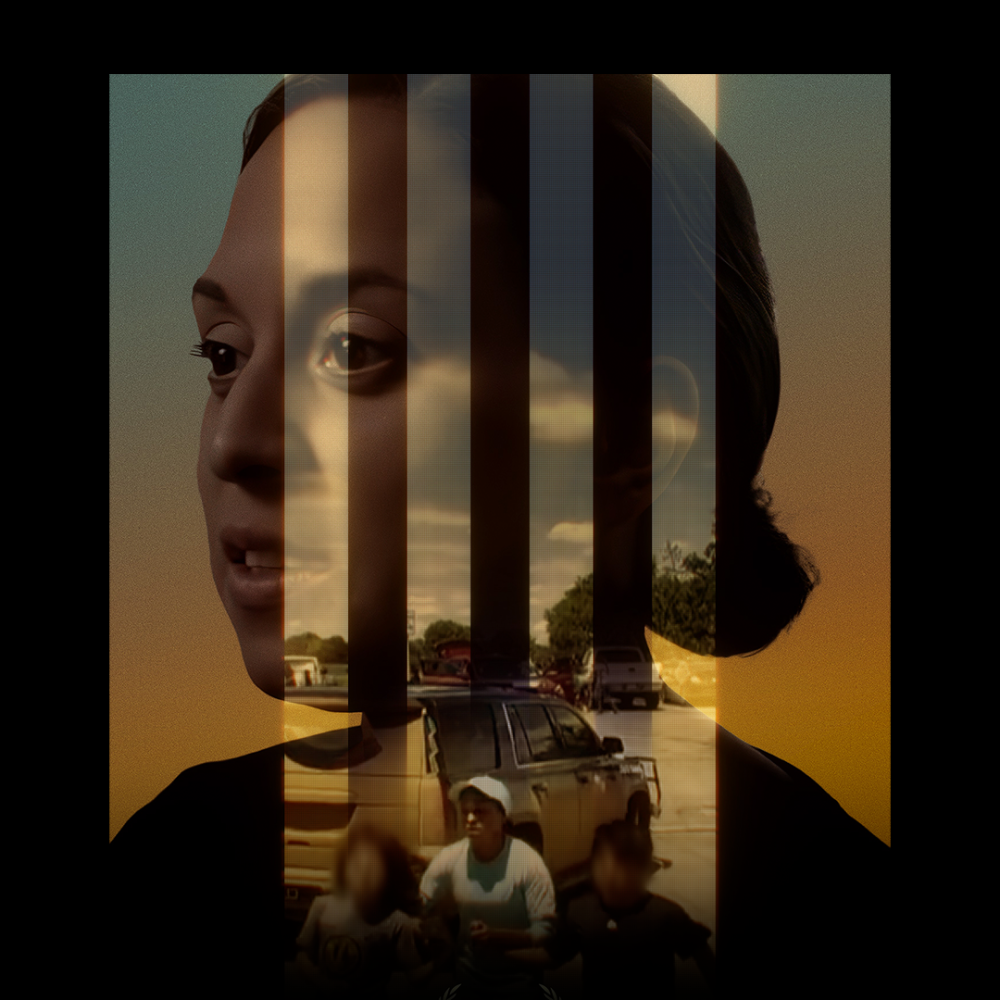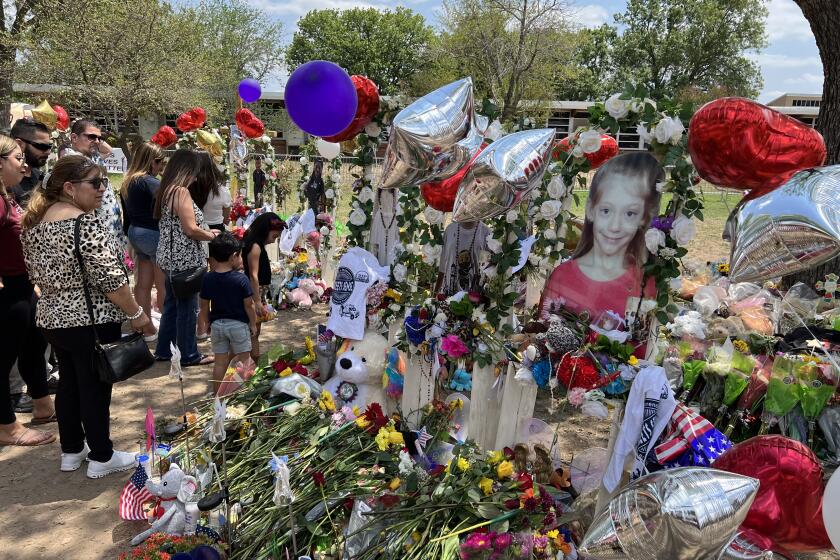
- Share via
Three years ago, an armed young man entered Robb Elementary School in Uvalde, Texas, and killed 19 students and two teachers. Hundreds of law enforcement officials reportedly stood around the school campus for more than an hour without approaching the shooter.
In the midst of the inaction, one mom — Angeli Rose Gomez — pleaded with officers to take action or let her go in to get her two children and nephew. She was apprehended and handcuffed, but ultimately talked her way out of arrest before she sprinted inside the school to grab the kids.
Videos on social media captured the moments that Gomez brought her sons and nephew out of the school. The Texas field worker and mother of two was quickly dubbed a hero in national and local publications for her courage.
The new documentary film “Uvalde Mom” follows Gomez after becoming nationally recognized — while examining the forces at play in the Uvalde community which allowed for the shooting to take place, as well as the aftermath of such a tragedy.

“All I wanted that day was my kids to come out of the school alive, and that’s what I got,” Gomez says in one pivotal moment in the film. “I don’t want to be called a hero. I don’t want to be looked at as the hero because the only job that I did that day was being a mom.”
A sweeping new Justice Department report that highlights the failures of Uvalde first responders is also a primer on effective approaches to mass violence.
The feature’s director Anayansi Prado was “moved” and “horrified” by what had happened and felt motivated to make a film about the event after seeing members of the affected families on TV.
“I saw that there were Latinos, they were Mexican American, that it was a border town, that it was an agricultural farming town, and that really resonated with me and with communities I’ve done film work with before,” Prado told The Times.
Prado began reaching out to people in Uvalde shortly after the shooting, but didn’t hear back from anyone for over two months due to the inundation of media requests everyone in the city was receiving. The only person to reply to her was Gomez.
Ahead of the film’s screening Saturday at the Los Angeles Latino International Film Festival, Prado spoke with The Times about the process and the challenges of making her documentary.
This interview has been edited and shortened for clarity.
Was the idea always for this project to be a feature-length film? Or were there talks of making it a short or a series?
I’ve always thought about it as a feature because I really wanted to dive in and understand Uvalde as a character. I wanted to understand the history of the criminal justice system, the educational system. I knew I wanted to make something that was going to be of a longer form rather than just a piece that was about Angeli or something. And a few people told me this would make a great short, but as I uncovered more about Uvalde, I was like, “No, Uvalde itself has its own history, just like a person.”
The families also agreed to a $2-million settlement with the city, under which Uvalde leaders promised higher standards and better training for police.
When it came to choosing Angeli, was she the first and only person who responded to your outreach?
I think the people in town were oversaturated with media coverage, and Angeli was the one that got back to me. What was really interesting is that I learned on that first trip [to Uvalde] about her backstory and I learned about how the criminal justice system had failed her. I saw a parallel there of how the system failed the community the day of the shooting and how it was failing this woman also individually. I wanted to play with those two stories, the macro and the personal. Once I learned who she was, beyond the mom who ran into the school, I was like, “I have to tell this woman’s story.”
How did you go about balancing her personal stuff and the failures that happened on a larger scale?
So much of the way the film is structured is reflective of my own experience as a filmmaker. It was a sort of surreal world, these two worlds were going on: what was happening to Angeli and then what was going on outside with the lack of accountability and the cover-up. So that informed the way that I wanted to structure the film.
In terms of the personal, it was a journey to gain Angeli’s trust. At some point at the beginning, she wasn’t sure she wanted to participate in the film, and so I told her, “You don’t owe me anything. I’m a stranger, but all I ask is that you give me a chance to earn your trust.” And she was like, “OK.” From there on, she opened up and, pretty quickly, we became close and she trusted me. I was very cognizant [of] her legal past and even the way she’s perceived by some folks. I also didn’t want Angeli to come off as a victim and people to feel sorry for her, but I still wanted to tell her story in a way where you get mad at the system for failing her.
What kind of struggles did you have trying to get in communication with some of the officials of the city?
We used a lot of news [archives] to represent that part of the story. The [authorities] weren’t giving any interviews, they were just holding press conferences. So access was limited, but also the majority of the time that we were filming, we were very low-key about the production — because Angeli was on probation and there was retaliation for her speaking to the media. We tried to keep it under wraps that we were filming, so not a lot of people knew about it [besides] her family. Obviously other folks in town [were] part of the film, like her friend Tina and family members. Outside of that, it was too risky to let other people in town know what was going on.
The Justice Department has issued a highly critical report on the police response to the school shooting in Uvalde, Texas, that killed 21 people.
Ultimately I wanted to make [“Uvalde Mome”] a personal portrait. I was just very selective on the people that we absolutely needed to interview. I’m happy with Tina, who’s an activist in town, and Arnie, a survivor of the shooting and a school teacher, [plus] Angeli’s legal team. I felt like those were people we needed to tell a fuller story. But we just couldn’t be out in the open making a film about her and let people know.
What kind of reception have you gotten from people of Uvalde that have seen the film?
We had our premiere at South by Southwest, which was great. A lot of folks came from Uvalde and spoke about how, almost three years later, a lot of this stuff is still going on. Every time Gov. Greg Abbott came on-screen, people would scream, “Loser!” It was really moving to have those screenings.
As was expected from the folks who are not fans of Angeli, there was some backlash. It’s the same narrative you see in the film of, “She’s a criminal, don’t believe her.” It’s a town that is an open wound. I just try to have compassion for people. Ultimately, Angeli’s story is the story of one person in Uvalde of many that need to continue to be told. And I hope that other filmmakers, journalists and other storytellers continue to tell the story there, especially with the lack of closure and accountability. I’m happy that the film is putting Uvalde back into the headlines in some way; that way we don’t forget about it.
Had you ever spent an extended amount of time in Texas before?
I had been to Texas, but I hadn’t done a project in Texas. Because I’m an outsider, it was very important for me to hire a 100% local Texas crew for this film. My crew was entirely Texas-based, from our PAs to our sound to our DPs. I also wanted to have a majority Texas-born Mexican American crew so that they could guide me. We began production in September of 2022 and the atmosphere was very tense.
This is a story that is deeply rooted in the Latino community and the tension about the law enforcement in Uvalde. What was it like dealing with that tension and how did you personally feel that when you went into the town?
When I got to Uvalde, I saw that the majority of the Latino community had been there for several generations. You would think a town with that kind of Mexican American history, and them being the majority, that they’d be pretty cemented and represented, right? It was really eye-opening to see [how] these folks are still considered second-class citizens. A lot of them are being repressed. And then you have folks that get in positions of power, but they’re whitewashed in line with the white conservative agenda. So even those that are able to get into positions of power don’t lean towards the community. They turn their back on it.
I heard from folks that the history of neglect was what led to the response that day at Robb Elementary. And they’re like, “Yeah, that’s what happens on that side of town. You call the cops, they don’t come. Our schools are run-down.” You really see the disparity. This was a Mexican American community that had been there for a long time. It’s fascinating how the conservative white community, even if they’re the smaller part of the population, they can still hold the power.
More to Read
The Latinx experience chronicled
Get the Latinx Files newsletter for stories that capture the multitudes within our communities.
You may occasionally receive promotional content from the Los Angeles Times.









